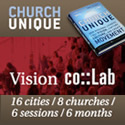The Future of the American Mega-Church
- Posted by: Todd
- Posted on: Tue, October 19, 2004
- Viewed 46
- (7) comments so far
"In 1984, there were only 20 known global churches with a weekend attendance of more than 3,900. In 1992, there were 44 churches that size in the U.S. alone. Outside the U.S., there were more than another 52 churches known to have at least 6,200 weekend attendees. This means that the number of really large churches increased more than five times from 1984 to 1992. As of mid-2004, there are at least 238 known U.S. churches with 3,900 weekend attendees, almost 15 times more than just two decades ago."
Trend 2: Large churches will, in many instances, continue to grow larger.
"Increases in the growth of U. S. congregations have been dramatic. From my best efforts to identify the diverse definitions of "large," it appears that the largest churches in the U.S. are no longer Catholic churches. The largest Roman Catholic congregation in this country appears to average about 10,000 attendees each weekend served by more than 10 masses. Even with the discussion of the decline in Catholic attendance and membership, there are a multitude of rapidly growing and large congregations. One younger Catholic researcher estimates that there may be as many as 5,000 Catholic mega-churches in the U.S. For non-Catholic congregations in the U.S., the meaning of "large" has changed significantly since 1980. The average weekend attendance among the 10 largest churches almost doubled from 1980 to 1990."
Trend 3: Large churches are requiring less time to reach mega-church size.
"How long does it take for a church to reach an attendance of 2,000 or more attendees?"
The answer, according to a 2004 study of 500 U.S. mega-churches by Church Growth Today, is:
38 percent of the mega-churches--60+ years
11 percent of the mega-churches--40-59 years
9 percent of the mega-churches--30-39 years
11 percent of the mega-churches--20-29 years
19 percent of the mega-churches--10-19 years
8 percent of the mega-churches --5-9 years
4 percent of the mega-churches--1-4 years
Trend 4: These churches will continue to be theologically conservative.
"While a church may be theologically conservative, it may also be socially liberal. This can be true of any ethnic group but is especially true among African-American and other minority churches. Seventy percent belong to denominations, 45 percent are Baptist, Assemblies, Christian or Presbyterian. Thirty percent are independent churches."
Trend 5: Researchers and church leaders will continue to explore the vital role of small groups.
"When it comes to small groups through Sunday school, Southern Baptists in the U.S. are the recognized leaders. For home groups, the U.S. leader is Bethany World Prayer Center in Baker, Louisiana. Globally, the leader of both home groups and Sunday school in a single congregation is probably the Yoido Full Gospel Church of Seoul, Korea."
You can see the complete article at The Church Report's website here.
What do you think? Is the day of the megachurch in America over, or just beginning? I'd love to hear your comments... please click the comments link below to share now...
It seems that many people are now saying that the day of the megachurch in America is over. And it is true, that many larger churches are taking a multi-site or multi-service approach instead of building bigger buildings and having large services. In the most recent issue of The Church Report magazine, Dr. John Vaughan tells what he thinks the future of America’s megachurches holds. As of July of 2004, there were around 240 non-catholic ‘megachurches’ (defined by having a weekend attendance of over 2,000. According to Vaughan, this is almost 15 times the number of megachurches just 20 years ago. Here is a summary of what Dr. Vaughan predicts for large churches…
![]()
-----
Comments
if you want a Globally Recognized Avatar (the images next to your profile) get them here. Once you sign up, they will displayed on any website that supports them.






phill on Wed, October 20, 2004
I think they are the future…but I am think multi sites are still part of the mega church. Like in Austin there is one church of four…four different locations that attract 4000 people each Sunday and is just getting larger…
So mega church does not need to be on one sight…it can be one church many locations…
Bernie Dehler on Wed, October 20, 2004
Article says:
“It seems that many people are now saying that the day of the megachurch in America is over. And it is true, that many larger churches are taking a multi-site or multi-service approach instead of building bigger buildings and having large services.”
I think the modern-day definition of “church” is all messed-up. Church should be a place where people gather to fellowship and worship. Instead, it’s now a big performance, by both the music and preacher. Then they create “small groups” to do what the church is really supposed to do.
Instead of making a mega-church, why don’t they just develop leaders and plant other churches. I don’t get it at all…??? Is it just about ego—who can build the biggest church, and get the most fame?
...Bernie
http://www.FreeGoodNews.com
Todd Rhoades on Wed, October 20, 2004
“Instead, it’s now a big performance, by both the music and preacher. Then they create “small groups” to do what the church is really supposed to do.”
Hey Bernie… not to pick on you again, http://www.mondaymorninginsight.com/images/smileys/smile.gif but, as I mentioned in another post about the multi-site church, I wonder where all this antimosity toward large churches comes from.
1. They are large. Thus the term mega-church (which I agree has a bad connotation). But the church we see in Acts was also large; and growing larger and larger by the day. And we see nothing in scripture that either says this was wrong or a bad thing. As a matter of fact, it was celebrated.
2. They have popular leaders. But so did the early church. Paul had to be tremendously well known. Actually, Paul’s model might have actually been the first multi-site church! He served as the main over-seer of many different groups; and they supported each other financially.
3. Small Groups. Small groups is where the community, friendship, and growth takes place; and I think it’s fair to say that this is true is a church of 50 or 15,000. If ‘small group’ is your definition of church, then any church over 8-12 people can’t really function according the purpose of a ‘church’.
4. Equipping leaders. It takes an incredible amount of leaders and equipping to pull off a large church. As a matter of fact, it takes an incredible amount of leaders and equipping to pull off a small church.
5. On the question of size. What should a church do? When should they no longer get bigger? Should they split and start new congregations at 100? 250? 500? 1,000? For example, the county where I live has probably 80-100 churches. Nearly all are under 100 in size. Nearly none is doing any significant Kingdom outreach. There are, however, a couple churches in the same area that are being effective in evangelism and outreach and discipleship. Those churches are larger in size. So would it be better to have 80 small churches who are complacent; or 3 larger ones that are being effective? (I’d almost guarantee that the 3 larger churches are seeing more results, training more leaders, and discipling more people than the other 80 put together.) And I’m not belittling the smaller churches at all… I’m just staying this to ask… why is everyone so upset and down on the larger churches?
One word comes quickly to mind, but I’ll refrain from using it here. http://www.mondaymorninginsight.com/images/smileys/smile.gif
Just my 2 cents worth… anyone have any thoughts?
Todd
Bernie Dehler on Wed, October 20, 2004
Hi Todd-
Interesting points. Yes, I am kinda upset about the mega-church thing. Let me reply to some of your points.
1. You say the church in Acts was big. Do you think they all met in the same building? Didn’t they meet in many houses?
2. Paul did not lead a multi-church. He developed leaders and planted churches—exactly what I’m suggesting. There’s nothing wrong with hierarchy in leadership, but everything wrong with cult personality worship (one leader on screens in multiple places, as if they are something extra special).
As if Billy Graham is some super apostle. Why does it take HIM to lead a crusade in LA? Why can’t the churches do it without him, amongst themselves? Because they are sick, because they don’t know how to get along (LA is just an example of a worldwide church issue). Churches compete with each other, until Billy comes to town. Then instead of solving the problem by getting churches to work together, we exasperate it by making Billy some kind of super hero.
That’s all I want to write for now, because it takes up too much space, and I don’t want to use it all up. Anyway, I’m sure enough feathers were ruffled with these comments.
I don’t have a jealous bone in my body, as some may think. I just think it’s pathetic how the churches can’t work together, and then other people take advantage of this and build themselves up. I just don’t get it.
I can’t believe these multi-site churches can’t find or develop a leader, so they have to have a video screen. I think it’s a serious and gross leadership problem.
PS: I just finished a seminary class called “Leadership.” I recommend the paperback book, one of the texts:
“The Making of a Christian Leader” by Ted Engstrom (Former Pres. of Youth for Christ).
PPS: Don’t worry about “picking on me.” I like you… so far http://www.mondaymorninginsight.com/images/smileys/wink.gif
...Bernie
http://www.FreeGoodNews.com
phill on Mon, October 25, 2004
I think we sometimes have the wrong idea of what takes place in large churches…I have served and pastored in small churches…and now an associate at a large church…and I see more development and ministry taking place here than anywhere I have been…not only in planting but raising up and releasing leaders…
Shane Montgomery on Mon, October 25, 2004
WOW – I am always amazed at how the church can justify its effectiveness by size. There is nothing inherently wrong with size large or small but the growth of a mega-church should never be deemed worthy because of the numbers in attendance, dollars in the budget or size of it’s campus/campuses. Our culture promotes and equates quality with quantity when it comes to spirituality. While I go to a large, local congregation I deeply desire more intimate worship, free of performance, ribbon dancers and 40-minute messages that feels more like a college lecture than a passionate call to be different. I know I am idealistic but I believe that the church should be populated by changed people who are cared for, led and equipped by a man or team of men who know the names of their flock and have at their core purpose, seeing their congregation become more Christ-like instead of putting on the next great conference and writing the next best seller.
For those who are not of the faint of heart, I recommend the book Working the Angles: The Shape of Pastoral Integrity
by Eugene H. Peterson. Here is what one reviewer said about the book on Amazon.com.
“The power, longevity and effectiveness of a church lies in large part on the leadership of its pastor(s). It shouldn’t be about his or her administrative skills or ability to jump at every whim a member of the congregation brings forward. It should be about the spiritual life and leadership of the pastor. This isn’t about perfection. It’s about relationship with God. As a lay person who is active in the local church and works in a ministry to pastors, my heart delights in a pastor who puts God first and everything else in its proper place. You see, when the pastor’s hunger for God is alive and well and being fed I can see it, and I have a role model to follow. When the pastor’s life demonstrates the results of intimacy with Christ, I am motivated and encouraged.
As a lay person, I was brought up short because for too long I have measured my pastors by the to do list he accomplishes and the teaching she does. I have not always allowed them the space to do the most important things - being the guardian and teacher of the word and sacrament, abiding in Christ through prayer, and being the spiritual director I need rather than the quick answer to a problem I bring forward. I stand corrected.
My hope is that this book crosses the desk of every pastor in America, to renew his or her call to ministry, to give permission and encouragement in keeping the promises of ordination and installation. It will radically change the pastorate and the Church it ministers to.
Well done, Pastor Peterson. Thank you for your honesty, your leadership, and your willingness to be real and tell it like it is.”
Andy McAdams on Tue, May 10, 2005
As a church consultant I have seen both the positive and the negative about the mega-church. There is no doubt that the super church can provide for more needs of families and offer more ministries. Not to mention the dynamic worship services that one can attend. The music is amazing; the crowd dynamic is exciting.
BUT…I personally have felt that those same churches unintentionally have created a negative effect on the more then 85% of smaller churches in between those super worship centers. The churches that are in serious decline because the grass is greener on the other side of town.
Mega-churches automatically pull sheep. Not on purpose, but it happens.
Mega-churches allow for a place for people under discipline (something churches are afraid to do now days) to hide. I once called a pastor of a very large church and informed him of someone from my church that was disciplined due to serious sin issues was attending his church. His response was, “what do you want me to do about it? They probably have gotten lost in the crowd.”
In the mega-church there is little need for people in the congregation to serve and they find it even harder to connect with people in meaningful fellowship.
In the mea-church people find less of a sense of ownership and a sense of being needed.
All too often the mega-church scatters the family to different parts of the campus in a society that family unity and worship is needed more now then ever.
In the mega-church, most discipleship is done in-group settings. Studies have shown that group studies are effective, but not nearly as effective as 1-1 discipleship, which is a major task in very large churches. 2 Tim. 2:2.
All one has to do is talk with the neighbors of may mega-churches and find out how they feel about their neighbors, it’s not good.
I am not totally negative toward the mega-church. I do see the blessings of God on them, but also see the struggles in the hearts of those pastors that watch their people leave to go to those mega-churches, because you can’t complete with them, only to think, “if they stayed we could have all those things that they are leving for.”
I have to wonder about of the 1,400 pastors that leave the ministry each month, how many of then do so because they are too close to one of those mega-churches and wonder, “what’s the use?”
Page 1 of 1 pages
Post a Comment